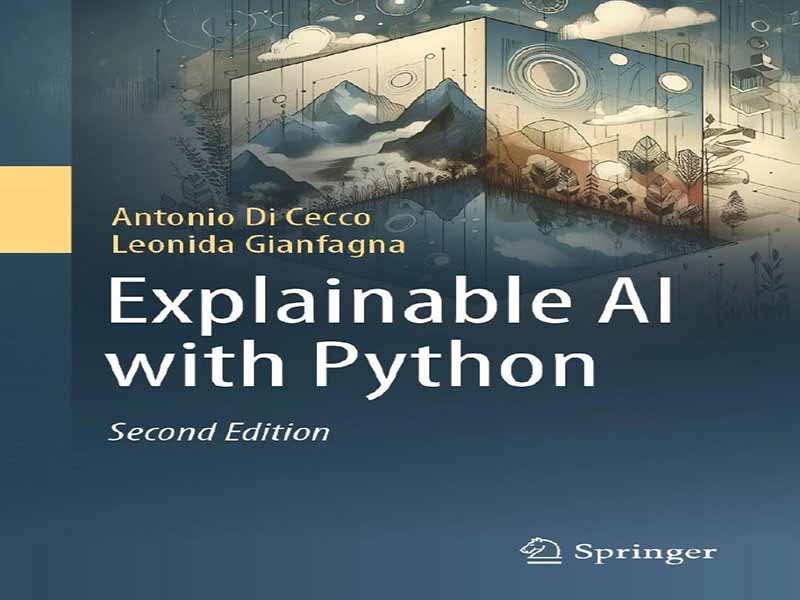- عنوان کتاب: Explainable AI with Python, 2nd
- نویسنده: Antonio Di Cecco, Leonida Gianfagna
- حوزه: برنامه نویسی هوش مصنوعی
- سال انتشار: 2025
- تعداد صفحه: 331
- زبان اصلی: انگلیسی
- نوع فایل: pdf
- حجم فایل: 6.29 مگابایت
هوش مصنوعی قابل توضیح با پایتون صرفاً یک راهنمای فنی نیست، بلکه سفری به یکی از جذابترین و متحولکنندهترین حوزههای هوش مصنوعی مدرن است. در زمانی که الگوریتمها از مجموعههای قطعی قوانین به سیستمهای پیچیده و دادهمحور تبدیل شدهاند، نیاز به وضوح و شفافیت هرگز تا این حد حیاتی نبوده است. این کتاب در پاسخ به این نیاز پدیدار شده است و خواننده را در چشمانداز یادگیری ماشینی با تمرکز ویژه بر رمزگشایی از ماهیت «جعبه سیاه» مدلهای معاصر راهنمایی میکند. این کتاب شرح جامعی از روشها و ابزارهایی ارائه میدهد که ما را قادر میسازد تا تصمیمات گرفته شده توسط سیستمهای پیچیده هوش مصنوعی را درک، تفسیر و در نهایت به آنها اعتماد کنیم. تکامل هوش مصنوعی در دهههای اخیر منجر به سیستمهایی شده است که با دقت قابل توجهی عمل میکنند، اما در عملکرد داخلی خود مبهم باقی میمانند. مهندسی نرمافزار سنتی به دستورالعملهای صریح متکی بود و تضمین میکرد که هر خروجی را میتوان مستقیماً به بخش خاصی از کد ردیابی کرد. در مقابل، مدلهای یادگیری ماشینی مدرن، به ویژه شبکههای عصبی عمیق، با مثال یاد میگیرند و ذاتاً پیچیده هستند و توضیح چگونگی رسیدن آنها به یک نتیجه خاص را چالش برانگیز میکند. هوش مصنوعی قابل توضیح (XAI) با توسعه روشهایی که شکاف بین مدلهای با عملکرد بالا و درک انسان را پر میکنند، به این چالش میپردازد. هدف آن ارائه توضیحاتی است که نه تنها از نظر فنی دقیق، بلکه از نظر شهودی نیز واضح هستند و در نتیجه قابلیت اطمینان سیستم را افزایش داده و درک را آسان میکنند. این کتاب به عنوان یک راهنمای قوی برای متخصصان و نظریهپردازانی که به دنبال پیمایش در این زمینه پیچیده هستند، مطرح میشود. این کتاب با ایجاد پایهای محکم در اصول یادگیری ماشین و نیاز ذاتی به شفافیت مدل آغاز میشود. از اصول یادگیری نظارت شده، بدون نظارت و تقویتی گرفته تا بحثهای ظریف در مورد محدودیتهای مدلهای جعبه سیاه، هر فصل برای ایجاد یک روایت منسجم طراحی شده است. از طریق توضیحات نظری دقیق و مثالهای عملی پایتون، از خوانندگان دعوت میشود تا روشهای متنوعی را که در قابل توضیح ساختن سیستمهای هوش مصنوعی به کار میروند، بررسی کنند – چه از طریق رویکردهای مدل-آگنوستیک که هوش مصنوعی را به عنوان یک جعبه سیاه در نظر میگیرند و چه از طریق روشهای ذاتی که قابلیت تفسیر را در معماری مدل میبافند. آنچه واقعاً این اثر را متمایز میکند، رویکرد جامع آن به موضوع است. نویسندگان به جای صرفاً فهرستبندی تکنیکها، به طور انتقادی بررسی میکنند که چرا قابلیت توضیح اهمیت دارد. در بسیاری از زمینههای حساس مانند مراقبتهای بهداشتی، مالی و سیستمهای حقوقی، تصمیمات هوش مصنوعی میتواند پیامدهای عمیقی برای افراد و جامعه داشته باشد. یک سیستم هوش مصنوعی که توضیحات واضح و قابل فهمی ارائه میدهد، احتمال بیشتری دارد که از سوی تنظیمکنندگان، متخصصان و عموم مردم پذیرفته شود. این کتاب با اطمینان از اینکه هر پیشبینی یا طبقهبندی قابل حسابرسی و درک است، دوره جدیدی از استقرار مسئولانه و اخلاقی هوش مصنوعی را پرورش میدهد و از شفافیت به عنوان یک اصل اساسی به جای یک ویژگی اختیاری حمایت میکند. ویرایش دوم با پرداختن به پیشرفتهای سریع در این زمینه، بر پایه قوی نسخه قبلی خود بنا شده است. نکته قابل توجه این است که اکنون دنیای مدلهای زبانی بزرگ و سیستمهای چندوجهی را بررسی میکند. این اضافات، روندهای فعلی در هوش مصنوعی را منعکس میکنند که در آن مدلها نه تنها متن را پردازش میکنند، بلکه دادههای بصری، شنیداری و حسگر را نیز ادغام میکنند تا بازنماییهای غنیتر و ظریفتری از جهان ایجاد کنند. گسترش به این حوزهها، بحثی را در مورد چگونگی شفاف و قابل تفسیر کردن چنین سیستمهای پیچیدهای بدون به خطر انداختن عملکرد به همراه دارد. علاوه بر این، بررسی پیشرفته مدلهای افزایشی، کاوش گستردهتری از نقش آنها در بهبود قابلیت تفسیر مدل ارائه میدهد. این بهروزرسانیها تضمین میکنند که این کتاب همچنان منبعی بهروز و ضروری برای هر کسی باشد که به ابعاد اخلاقی، فنی و عملی هوش مصنوعی قابل توضیح علاقهمند است. در سراسر صفحات این کتاب، تعادلی بین جزئیات فنی دقیق و روایت قابل فهم حفظ شده است. نویسندگان خوانندگان را نه تنها به یادگیری تکنیکها، بلکه به درک اصول اساسی که این روشها را مؤثر میسازد، دعوت میکنند. ترکیب نظریه و کاربرد عملی، سفری را ایجاد میکند که هم از نظر فکری تحریککننده و هم بلافاصله مفید است و خوانندگان را به مهارتهای لازم برای پیادهسازی روشهای XAI در سناریوهای دنیای واقعی مجهز میکند. در عصری که بحثها پیرامون اخلاق هوش مصنوعی و پاسخگویی در حال تشدید است، این کتاب این باور متعارف را که همیشه باید بین عملکرد و تفسیرپذیری، بدهبستان وجود داشته باشد، به چالش میکشد. در عوض، نشان میدهد که از طریق طراحی دقیق و تکنیکهای نوآورانه، عملکرد بالا میتواند با توضیحاتی که برای انسانها قابل درک هستند، همراه باشد. با خواندن این کتاب، بینشهایی در مورد روشهای XAI پیشرفته به دست میآورید و در عین حال به حرکت گستردهتری به سوی هوش مصنوعی مسئولانهتر نیز کمک میکنید. هوش مصنوعی قابل توضیح با پایتون دعوتی است برای پذیرش آیندهای که در آن فناوری
Explainable AI with Python is not merely a technical manual, but a journey into one of the most fascinating and transformative areas of modern artificial intelligence. At a time when algorithms have moved from being deterministic sets of rules to complex, data-driven systems, the need for clarity and transparency has never been more critical. This book emerges in response to that need, guiding the reader through the landscape of machine learning with a particular focus on demystifying the “black box” nature of contemporary models. It provides a comprehensive description of the methods and tools that enable us to understand, interpret, and ultimately have confidence in the decisions made by sophisticated AI systems. The evolution of artificial intelligence over recent decades has led to systems that perform with remarkable accuracy yet remain opaque in their inner workings. Traditional software engineering relied on explicit instructions, ensuring that every output could be directly traced to a specific part of the code. In contrast, modern machine learning models, especially deep neural networks, learn by example and are inherently complex, making it challenging to explain how they arrive at a particular conclusion. Explainable AI (XAI) addresses this challenge by developing methods that bridge the gap between high-performing models and human comprehension. It aims to provide explanations that are not only technically accurate but also intuitively clear, thereby enhancing system reliability and easing understanding. This book stands as a robust guide for both practitioners and theorists who seek to navigate this complex field. It begins by laying a solid foundation in the principles of machine learning and the intrinsic need for model transparency. From the fundamentals of supervised, unsupervised, and reinforcement learning to nuanced discussions on the limitations of black-box models, every chapter is designed to build a coherent narrative. Through detailed theoretical explanations and hands-on Python examples, readers are invited to explore diverse methodologies employed in making AI systems explainable—be it through model-agnostic approaches that treat the AI as a black box or intrinsic methods that weave interpretability into the model’s architecture. What truly distinguishes this work is its holistic approach to the subject. Rather than merely cataloguing techniques, the authors critically explore why explainability matters. In many high-stakes fields such as healthcare, finance, and legal systems, AI decisions can have profound implications for individuals and society. An AI system that offers clear and accessible explanations is more likely to gain acceptance from regulators, practitioners, and the public alike. By ensuring that every prediction or classification can be audited and understood, the book fosters a new era of responsible and ethical AI deployment, advocating for transparency as a core principle rather than an optional feature. The second edition builds upon the strong foundation of its predecessor by addressing rapid advancements in the field. Notably, it now investigates the world of large language models and multimodal systems. These additions reflect current trends in artificial intelligence where models process not only text but also integrate visual, auditory, and sensor data to form richer, more nuanced representations of the world. The expansion into these areas brings with it a discussion of how such complex systems can be made clear and interpretable without compromising performance. Furthermore, the enhanced treatment of additive models provides a more extensive exploration of their role in improving model interpretability. These updates ensure that the book remains an up-to-date and indispensable resource for anyone interested in the ethical, technical, and practical dimensions of explainable AI. Throughout its pages, the book maintains a balance between rigorous technical detail and accessible narrative. The authors invite readers not only to learn the techniques but also to understand the underlying principles that make these methods effective. The blend of theory and practical application creates a journey that is both intellectually stimulating and immediately useful, equipping readers with the skills needed to implement XAI methods in real-world scenarios. In an era where debates around AI ethics and accountability are intensifying, this book challenges the conventional wisdom that there must always be a trade-off between performance and interpretability. Instead, it demonstrates that through careful design and innovative techniques, high performance can go hand in hand with explanations that are comprehensible to humans. By reading this book, you gain insights into state-of-the-art XAI methods while also contributing to a broader movement towards more responsible artificial intelligence. Explainable AI with Python is an invitation to embrace a future where technology serves humanity in an open and ethical manner. Whether you are an experienced practitioner looking to refine your skills or a newcomer eager to grasp the complexities of modern AI, this book offers a comprehensive exploration of the field. It is a vital resource that empowers you to build AI systems whose decision-making processes can be clearly understood, ensuring that technological progress is aligned with principles of fairness and accountability.
این کتاب را میتوانید از لینک زیر بصورت رایگان دانلود کنید:
Download: Explainable AI with Python, 2nd



































نظرات کاربران